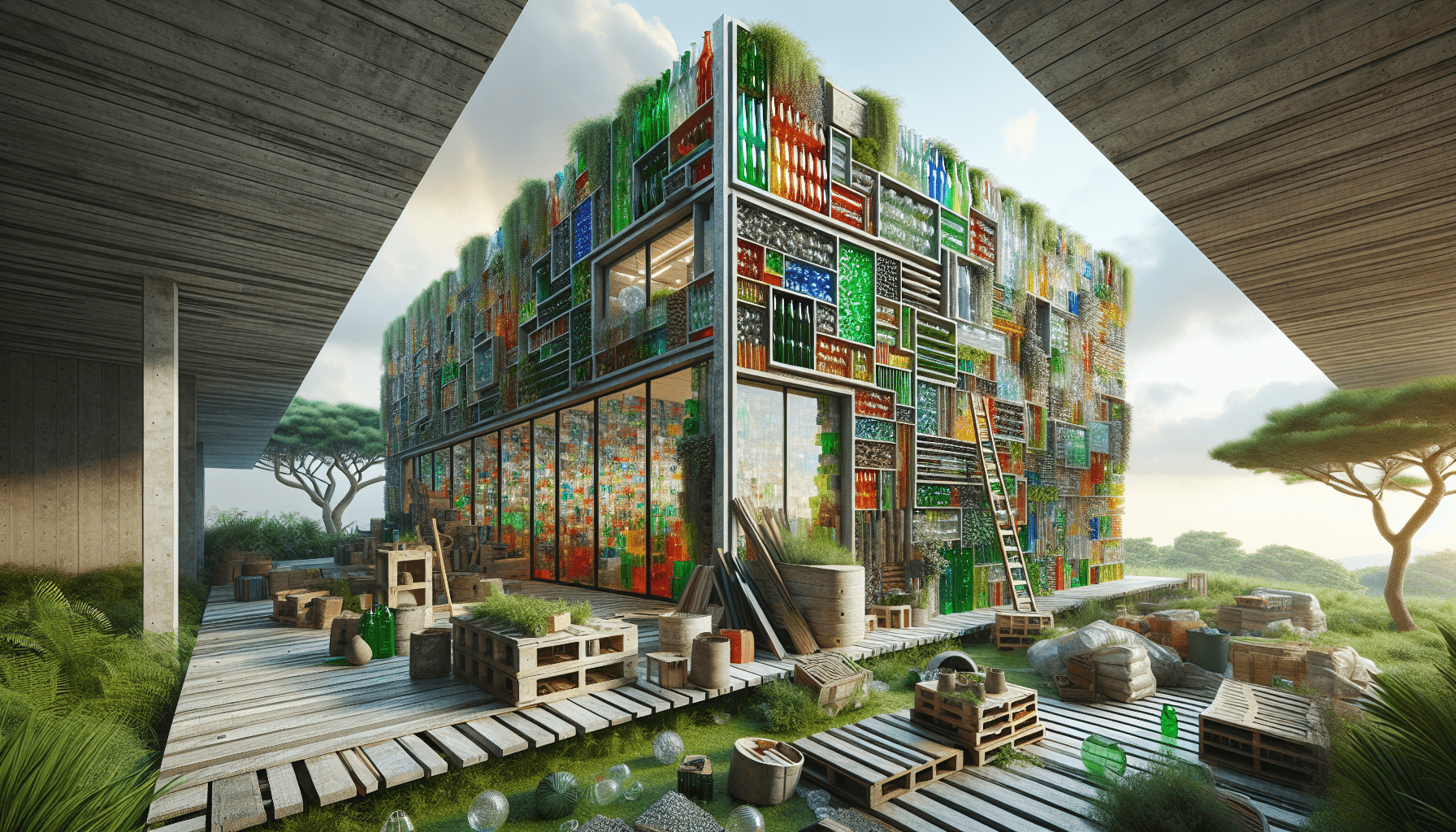How can we use recycled materials in construction? This question is becoming increasingly important as we look for sustainable ways to reduce waste and our environmental footprint. Construction is an essential industry, but it’s also one of the biggest contributors to waste and resource depletion. By using recycled materials, we can significantly lessen the environmental impact while also potentially reducing costs. So, let’s explore some innovative ways to incorporate recycled materials into construction projects.
Benefits of Using Recycled Materials in Construction
Before we delve into specific innovative ways to use recycled materials, it’s important to understand the myriad benefits. These benefits can range from environmental impacts to economic advantages.
Environmental Benefits
Using recycled materials helps to reduce the strain on natural resources. It minimizes the need for new raw materials, which leads to lower energy consumption and greenhouse gas emissions associated with the extraction, processing, and transportation of these materials. Additionally, recycling materials helps to decrease the amount of waste that ends up in landfills.
Economic Benefits
Incorporating recycled materials often reduces the overall cost of construction. Recycled materials can be less expensive to produce and purchase compared to new materials. Moreover, using recycled materials can attract environmentally conscious clients and provide access to green building incentives and certifications.
Social Benefits
Promoting the use of recycled materials fosters a culture of sustainability and environmental responsibility. It also supports industries and technologies that are innovating in the recycling sector, providing economic opportunities and jobs.
Common Recycled Materials in Construction
Let’s explore various materials that can be recycled and used effectively in construction.
Recycled Concrete
Concrete is one of the most commonly used materials in construction. Recycled concrete is made by grinding up old concrete from demolished buildings and using it as aggregate in new concrete.
- Benefits: Reduced waste in landfills, lower cost, reduced need for virgin aggregate
- Uses: Road base, backfill material, new concrete production
Recycled Wood
Recycled wood can come from old buildings, pallets, and other wooden structures. It’s often repurposed for new construction projects.
- Benefits: Saves trees, reduces landfill waste, retains character and history
- Uses: Flooring, beams, walls, furniture
Recycled Steel
Steel is one of the easiest materials to recycle due to its ability to be melted down and reshaped.
- Benefits: Highly durable, reduces the need for new steel production
- Uses: Structural components, roofing, reinforcements
Recycled Glass
Crushed glass can be used in various construction applications. It is often combined with other materials to enhance properties.
- Benefits: Reduces landfill waste, potential aesthetic appeal
- Uses: Concrete aggregate, countertops, flooring
Recycled Plastic
Plastic waste can be transformed into a variety of construction materials.
- Benefits: Alleviates the plastic waste crisis, versatile
- Uses: Insulation, piping, flooring tiles, composite lumber

Innovative Uses of Recycled Materials in Construction
More and more, we’re seeing innovative uses of recycled materials in construction. These methods not only help in achieving sustainability but also contribute to modern architectural aesthetics.
Green Concrete
Green concrete is an eco-friendly variation of traditional concrete. It incorporates various industrial by-products such as fly ash, slag cement, and recycled concrete aggregates.
- Benefits: Reduced carbon footprint, lower cost, high strength and durability
- Uses: Building foundations, pavements, bridges
Composite Lumber
Composite lumber is made from a mixture of recycled plastic and wood fibers. It’s designed to look and feel like natural wood while offering superior durability.
- Benefits: Resistant to rot and pests, low maintenance, longevity
- Uses: Decking, fencing, outdoor furniture
Eco-Bricks
Eco-bricks are made from non-recyclable plastic waste, encased in plastic bottles, and used as a building material.
- Benefits: Uses waste plastic, lightweight, cost-effective
- Uses: Wall construction, garden structures, community building projects
Reclaimed Brick
Reclaimed bricks are extracted from old structures and repurposed for new construction.
- Benefits: Keeps brick out of landfills, reduces the need for new bricks, adds character and history
- Uses: Building facades, fireplaces, pathways
Recycled Asphalt
Recycled asphalt pavement (RAP) is created by grinding up old asphalt and reusing it in new paving projects.
- Benefits: Conserves natural resources, reduces construction costs, promotes stronger bonds in new asphalt
- Uses: Roadways, parking lots, driveways
Case Studies of Recycled Materials in Construction
To illustrate how these recycled materials can be used practically, let’s look at some case studies from real-world construction projects.
The Edge, Amsterdam
The Edge is a state-of-the-art office building in Amsterdam, often cited as one of the greenest buildings in the world.
- Materials Used: Recycled concrete, steel, and glass
- Innovations: Incorporation of recycled materials in everything from the building’s structure to interior finishes
- Results: High energy efficiency, lower carbon footprint, enhanced sustainability credentials
Marston’s Brewery, Rutland Water, UK
Marston’s Brewery is a stunning example of how reclaimed materials can be used in a commercial setting.
- Materials Used: Reclaimed wood and bricks
- Innovations: Use of pre-existing materials to enhance the aesthetic while reducing costs
- Results: A visually appealing, durable, and sustainable building that embodies the principles of upcycling
The Bottle House, Nova Scotia, Canada
The Bottle House is a unique structure entirely made from recycled glass bottles.
- Materials Used: Glass bottles, cement
- Innovations: Creative use of bottles to create both walls and natural light features
- Results: A visually stunning and functional building that emphasizes the creative potential of recycled materials

Best Practices for Using Recycled Materials in Construction
Adopting recycled materials in construction involves much more than just choosing the right materials. It also requires adherence to best practices to ensure sustainability, safety, and effectiveness.
Material Quality Check
Ensure that all recycled materials meet the required standards for strength, durability, and safety. This often means partnering with certified suppliers who provide high-quality recycled materials.
Design with Recycled Materials in Mind
Architects and designers should incorporate recycled materials right from the planning stage. This makes it easier to integrate these materials into the overall structure effectively.
Regulatory Compliance
Make sure your projects comply with local, national, and international regulations regarding the use of recycled materials. This may involve obtaining specific permits or certifications.
Lifecycle Assessment
Consider the lifecycle impacts of using recycled materials, from sourcing to disposal. This will help in making more informed decisions and achieving the highest sustainability goals.
Educate and Involve Stakeholders
Educate all involved parties, including clients, contractors, and laborers, about the benefits and methods of using recycled materials. Involving them from the start ensures smoother project execution.
Continuous Improvement
Recycling technology and methods are continually evolving. Stay up-to-date with the latest advancements to incorporate new and more efficient practices into your construction projects.
Future of Recycled Materials in Construction
As technology and awareness evolve, the future of recycled materials in construction looks increasingly promising. Here are some trends that are likely to shape the future.
Advanced Recycling Technologies
Technological advancements in recycling are allowing for the production of higher-quality recycled materials that can be used in more complex and demanding applications.
Smart Materials
Smart materials made from recycled sources are being developed to offer enhanced functionalities such as self-healing properties, load-bearing capabilities, and environmental adaptability.
3D Printing with Recycled Materials
3D printing is paving the way for the use of recycled materials in creating custom, precise building components. This technology can greatly reduce waste and offer more sustainable building solutions.
Global Standards and Practices
International standards and practices for the use of recycled materials are likely to become more stringent and widespread, encouraging their adoption globally.
Circular Economy
The concept of a circular economy—where materials are reused, repaired, and recycled continuously—will further drive the use of recycled materials in construction.

Conclusion
Incorporating recycled materials in construction is not just an innovative approach; it’s a necessary one for a sustainable future. The benefits are vast, ranging from environmental, economic, to social impacts. By adopting best practices and staying abreast of emerging technologies, we can make significant strides in reducing the environmental footprint of the construction industry.
From recycled concrete and wood to innovative solutions like green concrete and eco-bricks, the potential applications are numerous and extraordinarily impactful. Through real-world examples and adherence to best practices, we can not only envision but also build a more sustainable and resilient future.




